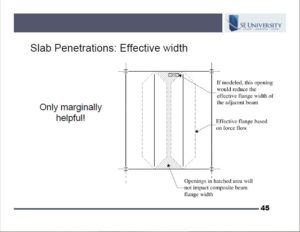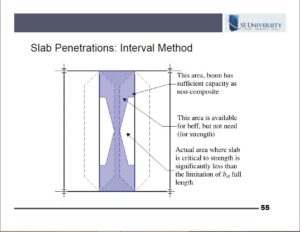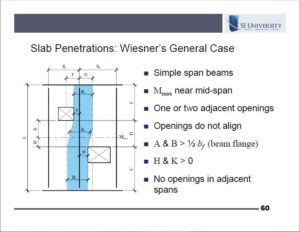Have you recently had a project where an architect insisted on running ductwork through the slab at an inconvenient location for your composite steel beam? Perhaps you have a building that is changing occupancy and you need to determine the absolute maximum composite strength available in an existing beam section with a new slab opening being added? Slab penetrations can be negligent when small and placed appropriately, however, engineers do not always have the luxury of ideal placements for MEP systems or various architectural features that may interfere with the structural system.
In the October 2016 session of SE University, Advanced Topics in Composite Steel Beam Design: Retrofit, Slab Openings, and Changes to Minimum Percent Composite, Susan Burmeister, PE, from S2B Structural Consultants, PLLC, reviewed three procedures that can be used to determine the maximum available capacity for a composite steel beam when slab penetrations are nearby. The three procedures include using a standard effective flange profile per AISC I3.1a, the Interval or Step Method, and the Wiesner Method.
The most common method is the standard effective flange width profile as included in AISC I3.1a, where the effective width is the sum of the effective widths to each side of the beam, limited to the following:
- One-eight of the beam span
- One-half the distance to the adjacent beam
- The distance to the edge of the slab
Most software programs use this method, and when slab openings or penetrations are modeled, the program will limit the effective flange width (on the opening side) to the distance from the beam centerline to the edge of the opening. Susan did note that small penetrations near the end of a beam may not affect the flange width based on the actual shear flow, as shown in the slide below. In this case, care would need to be taken during a software analysis, because the opening may need to be considered for the girder but not the beam.
If the slab opening, extends outside of the small hatched areas above, the engineer would need to advance to using the Interval or Step Method to see if this shaded section can be expanded to include additional areas where openings may not impact the beam strength. The Interval Method allows the engineer to determine the the necessary length along the beam where the larger effective flange compressive strength from the slab is necessary to contribute to the composite strength of the beam to meet the load demand. If the composite beam capacity is capable of supporting the required load, then the blue shaded areas below are then available to allow for slab penetrations in the areas where the non-composite strength of the beam can support the necessary load. Susan noted that this procedure only determines strength capacity, but not serviceability issues such as deflections.
Additionally, Susan reviewed the Wisener Method, which allows the engineer to determine the available composite beam strength when two openings that do not align occur within the same span. Thus, the effective flange width of the composite beam ‘snakes’ its way down the span which results in three different effective span widths throughout the beam length. Wisener presented his method in an article for Modern Steel Construction in March of 1996.
Although these more extensive design methods are not necessarily needed for all slab penetrations, they can be helpful tools in unique circumstances, where the engineer needs to maximize the available capacity of a composite beam while allowing for an inconvenient slab opening.



